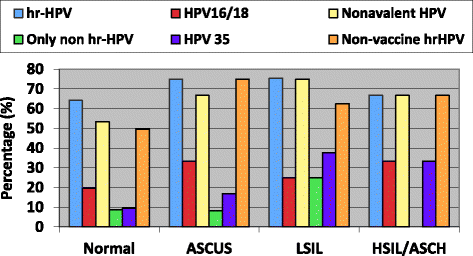Epidemiology of cervical human papillomavirus (HPV) infection and squamous intraepithelial lesions (SIL) among a cohort of HIV-infected and uninfected Ghanaian women
- PMID: 29037188
- PMCID: PMC5644111
- DOI: 10.1186/s12885-017-3682-x
Epidemiology of cervical human papillomavirus (HPV) infection and squamous intraepithelial lesions (SIL) among a cohort of HIV-infected and uninfected Ghanaian women
Abstract
Background: There is limited data in Ghana on the epidemiology of HPV and cervical neoplasia and their associations with HIV. This study aimed to compare among HIV-1 seropositive and HIV-seronegative Ghanaian women: (1) the prevalence, genotype distribution and risk factors associated with cervical HPV infection; and (2) the prevalence and risk factors associated with abnormal cervical cytology.
Methods: A comparative frequency-matched study was conducted in a systematic sample of women aged ≥18 years attending HIV and general outpatient clinics in Cape Coast Teaching Hospital, Ghana. Participants were interviewed and cervical samples collected for HPV genotyping (Seegene Anyplex-II HPV28) and cytological testing.
Results: Overall, 333 women were recruited, 163 HIV-1 seropositive and 170 HIV-seronegative women of mean age 43.8 years (SD ±9.4)) and 44.3 years (SD ±12.8), respectively. The prevalence of 14 high-risk (hr) HPV genotypes was higher among HIV-1 seropositive women (65.6% vs. 30.2%, P < 0.0001), as was proportion with multiple hr.-HPV infections (60.6% vs. 21.3%, P < 0.0001). HPV35 was the most prevalent hr.-HPV genotype in both groups (11.9% and 5.3%). The main factors associated with hr.-HPV infection were age for HIV-positive women and circumcision status of main sexual partner for both HIV-negative and positive women. Abnormal cervical cytology prevalence was higher among HIV-1 seropositive women (any SIL: 14.1% vs. 1.2%, P < 0.0001; low-grade SIL [LSIL]: 4.9% vs. 0.6%, P = 0.02; high-grade SIL: 1.8% vs. 0%, P = 0.07). Among HIV-1 seropositive women, number of pregnancies and CD4+ cell count were associated with LSIL+ cytology. There was strong association between LSIL+ abnormalities and HPV35 (aOR = 4.7, 95%CI: 1.3-17.7, P = 0.02).
Conclusions: HIV-1 infected women bear significant burden of HPV infection and related disease. Prevention and screening programmes should be specifically deployed for this population in Ghana.
Keywords: Cervical cancer; Genotyping; Ghana; Human immunodeficiency virus (HIV); Human papillomavirus (HPV); Squamous intraepithelial lesions (SIL).
Conflict of interest statement
Ethics approval and consent to participate
Ethical approval was obtained from the Committee on Human Research Publications and Ethics (CHRPE) of the School of Medical Sciences (SMS), Kwame Nkrumah University of Science and Technology (KNUST). Study participants signed or thumb printed written informed consent indicating consent to participate.
Consent for publication
Not applicable.
Competing interests
The authors declare no competing interest be it financial or non-financial.
Publisher’s Note
Springer Nature remains neutral with regard to jurisdictional claims in published maps and institutional affiliations.
Figures
Similar articles
-
High risk human papillomavirus prevalence and genotype distribution among women infected with HIV in Manaus, Amazonas.Virol J. 2018 Feb 17;15(1):36. doi: 10.1186/s12985-018-0942-6. Virol J. 2018. PMID: 29454382 Free PMC article.
-
Human papilloma virus infection in HIV-infected women in Belgium: implications for prophylactic vaccines within this subpopulation.Eur J Cancer Prev. 2018 Jan;27(1):46-53. doi: 10.1097/CEJ.0000000000000271. Eur J Cancer Prev. 2018. PMID: 27359375
-
Human papillomavirus and abnormal cervical lesions among HIV-infected women in HIV-discordant couples from Kenya.Sex Transm Infect. 2020 Sep;96(6):457-463. doi: 10.1136/sextrans-2019-054052. Epub 2020 Jan 9. Sex Transm Infect. 2020. PMID: 31919275 Free PMC article.
-
The recent natural history of human papillomavirus cervical infection in women living with HIV: A scoping review of meta-analyses and systematic reviews and the construction of a hypothetical model.HIV Med. 2023 Aug;24(8):877-892. doi: 10.1111/hiv.13490. Epub 2023 Apr 16. HIV Med. 2023. PMID: 37062862
-
HIV-positive women have higher risk of human papilloma virus infection, precancerous lesions, and cervical cancer.AIDS. 2018 Mar 27;32(6):795-808. doi: 10.1097/QAD.0000000000001765. AIDS. 2018. PMID: 29369827 Free PMC article.
Cited by
-
Persistence of oncogenic and non-oncogenic human papillomavirus is associated with human immunodeficiency virus infection in Kenyan women.SAGE Open Med. 2020 Jul 28;8:2050312120945138. doi: 10.1177/2050312120945138. eCollection 2020. SAGE Open Med. 2020. PMID: 32782796 Free PMC article.
-
The distribution of hrHPV genotypes among cervical cancer cases diagnosed across Ghana: a cross-sectional study.BMC Infect Dis. 2024 Mar 27;24(1):356. doi: 10.1186/s12879-024-09166-7. BMC Infect Dis. 2024. PMID: 38539128 Free PMC article.
-
Distribution of high- and low-risk human papillomavirus genotypes and their prophylactic vaccination coverage among West African women: systematic review.J Egypt Natl Canc Inst. 2023 Dec 7;35(1):39. doi: 10.1186/s43046-023-00196-x. J Egypt Natl Canc Inst. 2023. PMID: 38060078
-
High genotypic diversity of human papillomavirus among women in Cameroon: implications for vaccine effectiveness.IJID Reg. 2022 Oct 6;5:130-136. doi: 10.1016/j.ijregi.2022.09.014. eCollection 2022 Dec. IJID Reg. 2022. PMID: 36313603 Free PMC article.
-
Knowledge and experience of a cohort of HIV-positive and HIV-negative Ghanaian women after undergoing human papillomavirus and cervical cancer screening.BMC Womens Health. 2019 Oct 23;19(1):123. doi: 10.1186/s12905-019-0818-y. BMC Womens Health. 2019. PMID: 31647013 Free PMC article.
References
MeSH terms
LinkOut - more resources
Full Text Sources
Other Literature Sources
Medical
Research Materials


